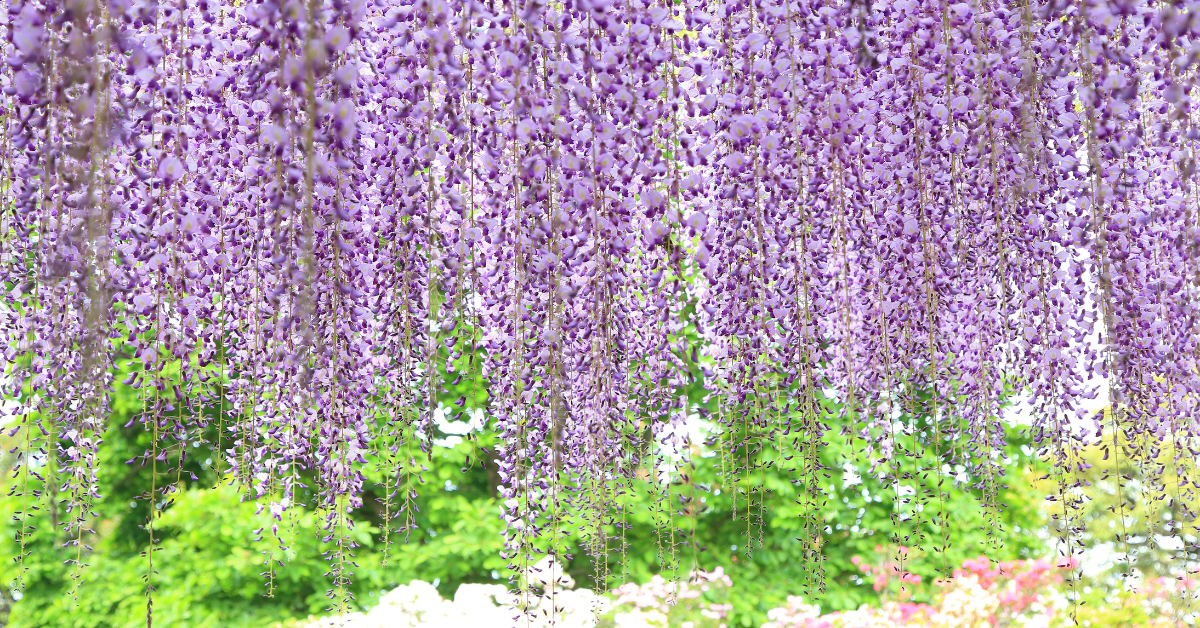Ashikaga Flower Park in Tochigi Prefecture is world-renowned for its breathtaking wisteria. Recognized as a sacred place for Demon Slayer fans, its scenery strongly resembles Mt. Fujikasane from the anime, attracting countless visitors.
Ashikaga Flower Park and Demon Slayer
Ashikaga Flower Park is home to a giant wisteria tree over 160 years old, along with hundreds of other blooming wisterias. Walking beneath the vast wisteria trellis feels like being surrounded by purple clouds, leaving visitors in awe.
In Demon Slayer, Mt. Fujikasane is depicted as a mountain entirely covered in wisteria, forming a barrier that keeps demons away. This fantastical depiction and the park’s real scenery overlap, leading many visitors to say, “This is exactly like Mt. Fujikasane.” Especially during the nighttime illumination, visitors often feel as though they have stepped directly into the world of the anime. For fans, the park holds a special significance as both a natural wonder and a cultural landmark.
Best Time to See Wisteria and Its Varieties
Wisteria at Ashikaga Flower Park is best enjoyed from mid-April to mid-May. Since the varieties bloom in succession, the scenery changes week by week, allowing for an extended viewing season.
| Variety | Best Viewing | Features |
|---|---|---|
| Light Pink Wisteria | Mid-April | Delicate pink blossoms herald the start of spring |
| Great Wisteria (160 years old) | Late April | A massive trellis spanning 600 tatami mats in area |
| White Wisteria | Early May | Pure white blooms, stunning under night illumination |
| Double-Petal Purple Wisteria | Early May | Long, deep purple flower clusters with a luxurious look |
The succession of blooms means that every visit offers a different experience, from the delicate pinks of early spring to the majestic purple cascades in full bloom. The Great Wisteria in particular is the park’s symbol, overwhelming visitors with its scale and beauty.
Night Illumination and Dreamlike Scenery
Beyond its daytime beauty, the wisteria transforms under nighttime illumination, becoming a magical sight. When lit, the blossoms radiate a mystical glow, transporting visitors to another world.
Key illuminated spots include:
| Spot | Feature |
|---|---|
| White Wisteria Tunnel | Feels like walking through a glowing pathway |
| Great Wisteria Reflected in the Pond | Mirror-like water doubles the beauty |
| Illuminated Double-Petal Wisteria | Deep purple blooms enhanced by dramatic lighting |
The illumination is so photogenic that many visitors stroll with cameras in hand. The White Wisteria Tunnel at night is especially popular, creating one of the park’s most iconic experiences.
Access and Nearby Attractions
Ashikaga Flower Park is just a few minutes’ walk from Ashikaga Flower Park Station on the JR Ryomo Line, making it highly convenient for travelers. During peak bloom, the area becomes very crowded, so public transport is strongly recommended.
Nearby sightseeing spots and local foods include:
| Spot | Feature |
|---|---|
| Ashikaga School | Japan’s oldest academic institution, rich in history |
| Orihime Shrine | Famous for blessings of love and matchmaking |
| Ashikaga City Center | Retro streets with traditional sweet shops |
Combining the park with local sightseeing makes for a fulfilling trip. Enjoying regional dishes such as Ashikaga shumai dumplings and traditional sweets adds even more charm to the visit.
Wisteria and Regional Revitalization
The wisteria at Ashikaga Flower Park provides not only breathtaking beauty but also significant economic and cultural benefits to the region. During the blooming season, hundreds of thousands of domestic and international visitors flock to the park, boosting hotels, restaurants, and local businesses.
The impact of wisteria on the region can be summarized as follows:
| Impact | Details |
|---|---|
| Economic Effect | Increased demand for accommodation and dining |
| Tourism Resource | Enhanced appeal thanks to the Demon Slayer connection |
| Regional Branding | Local products and souvenirs inspired by wisteria |
For the local community, the wisteria is a source of pride. It has been lovingly maintained for generations, ensuring that visitors can experience its splendor year after year. The flowers serve as both a cultural treasure and a driving force for the future of the region.
Conclusion
Ashikaga Flower Park is a place that combines the natural beauty of wisteria with the cultural excitement of being a Demon Slayer pilgrimage site. From the overwhelming daytime blooms to the enchanting night illumination, and from its impact on tourism to its role as a local symbol, the park continues to impress visitors from around the world.
The resemblance to Mt. Fujikasane allows fans to relive the anime’s atmosphere, while flower lovers can simply marvel at one of nature’s masterpieces. Everyone who visits leaves with unforgettable memories and a desire to return.






